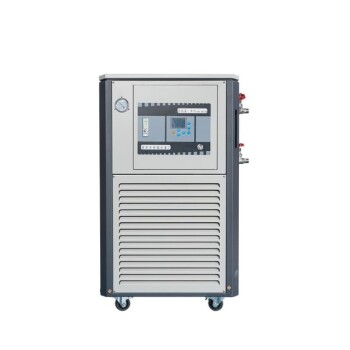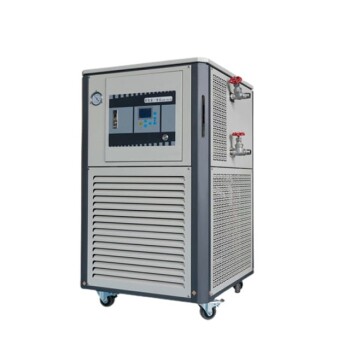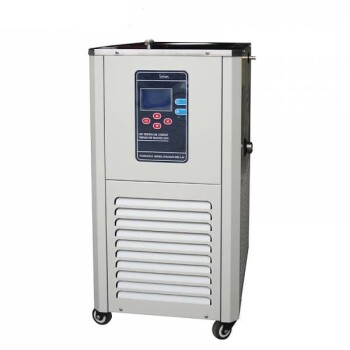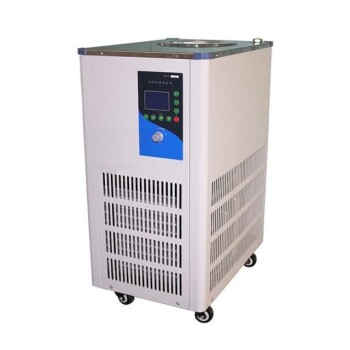At its core, system temperature control is a process that automatically maintains a device, substance, or environment at a desired, stable temperature. It works by continuously measuring the current temperature and activating a heating or cooling element to counteract any deviations from a predetermined setpoint. This is essential for the proper functioning of sensitive equipment like lasers, optics, and biological samples.
The fundamental purpose of a temperature control system is to create a stable thermal environment. It achieves this through a continuous feedback loop: a sensor measures the temperature, a controller compares it to a setpoint, and an actuator takes action to heat or cool as needed.

The Core Components of Temperature Control
A temperature control system is best understood as a team of three specialized components working together in a closed loop.
The Sensor (The "Eyes")
The sensor's only job is to accurately measure the current temperature of the object or environment being controlled.
The type of sensor depends on the temperature range. For example, a thermocouple is often used for temperatures below 1700°C, while an infrared instrument might be used for even higher temperatures.
The Controller (The "Brain")
The controller is the decision-making center of the system. It receives the temperature reading from the sensor.
Its primary function is to compare this reading to the preset value, also known as the setpoint. Based on the difference, it sends a command to the actuator.
The Actuator (The "Hands")
The actuator is the component that physically changes the temperature. It acts on the commands sent by the controller.
This could be a simple heating element, like a plate that turns on to raise the temperature. It could also be a more complex thermoelectric device (also called a Peltier device), which can actively both heat and cool.
The Control Loop in Action
The process of maintaining temperature is a continuous, automatic cycle.
1. Setting the Target
First, an operator defines the desired temperature by setting the preset value on the controller.
2. Continuous Measurement
The sensor constantly monitors the system's temperature and reports its findings back to the controller in real-time.
3. Making a Decision
The controller perpetually asks a simple question: "Is the measured temperature the same as the setpoint?"
If the temperature is too low, the controller signals the actuator to add heat. If it's too high, it may signal it to stop heating or to actively cool.
4. Taking Action
Following the controller's command, the actuator engages. For instance, if the temperature drops below the setpoint, the heating element is automatically turned on.
Once the sensor reports that the temperature has returned to the setpoint, the controller tells the actuator to turn off. This cycle repeats endlessly to maintain stability.
Understanding the Trade-offs
While the goal is simple, the implementation involves important considerations that affect performance and cost.
On/Off vs. Proportional Control
The simplest method is on/off control, as described with the heating plate. It's either fully on or fully off. This is cost-effective but can lead to temperature overshooting and undershooting the setpoint.
More advanced systems use proportional control, where the actuator's output can be varied. A thermoelectric cooler, for example, can apply a small amount of cooling or a large amount, allowing for much finer and more stable temperature adjustments.
Heating-Only vs. Heating and Cooling
Some applications only require keeping an object warmer than its surroundings. A simple heating element is sufficient for this.
Other applications, especially for sensitive electronics or scientific instruments, require holding a precise temperature regardless of whether the ambient environment is warmer or cooler. This necessitates an actuator like a Peltier device that can both heat and cool.
Making the Right Choice for Your Goal
The ideal temperature control strategy depends entirely on the specific requirements of your application.
- If your primary focus is general warming with moderate precision: A simple on/off system with a heating element is often the most reliable and cost-effective solution.
- If your primary focus is high-precision stability for sensitive components: A system using proportional control with a thermoelectric (Peltier) device is necessary to provide active heating and cooling.
- If your primary focus is monitoring and controlling industrial processes at extreme temperatures: Specialized sensors, such as thermocouples or infrared instruments, are the critical starting point for system design.
Ultimately, choosing the right system is about matching the precision of your tools to the sensitivity of your task.
Summary Table:
| Component | Role | Key Examples |
|---|---|---|
| Sensor | Measures current temperature | Thermocouple, Infrared Instrument |
| Controller | Compares reading to setpoint | On/Off Controller, Proportional Controller |
| Actuator | Applies heating or cooling | Heating Element, Thermoelectric (Peltier) Device |
Need precise temperature control for your lab? KINTEK specializes in lab equipment and consumables, providing reliable temperature control solutions for sensitive instruments and samples. Whether you need simple warming or high-precision stability, our expertise ensures your processes run smoothly. Contact us today to find the perfect system for your application!
Visual Guide

Related Products
- High Temperature Constant Temperature Heating Circulator Water Bath Chiller Circulator for Reaction Bath
- 20L Heating Chilling Circulator Cooling Water Bath Circulator for High and Low Temperature Constant Temperature Reaction
- 30L Heating Chilling Circulator Cooling Water Bath Circulator for High and Low Temperature Constant Temperature Reaction
- 10L Heating Chilling Circulator Cooling Water Bath Circulator for High and Low Temperature Constant Temperature Reaction
- Manual High Temperature Heated Hydraulic Press Machine with Heated Plates for Lab
People Also Ask
- Why does heating increase temperature? Understanding the Molecular Dance of Energy Transfer
- What are the factors affecting heat transfer efficiency? Optimize Your Thermal Management System
- How does a water bath work? Master Precise and Gentle Heating for Your Lab
- What is the function of a water bath? Achieve Precise, Gentle Heating for Your Lab Samples
- Does water bath evaporate? Yes, and here’s how to control it effectively.



















